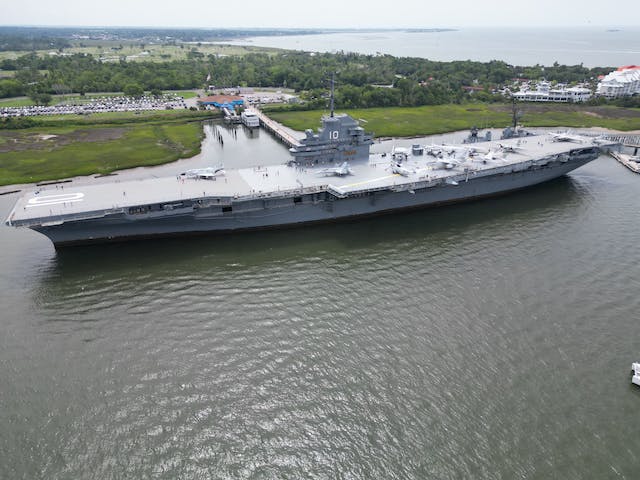India will add Aircraft Carrier, worth $4.8 Billion)
India is preparing to enhance its naval capabilities by adding another aircraft carrier to its fleet, valued at nearly ₹40,000 crore ($4.8 billion), in order to counter China’s growing presence in the Indian Ocean region. The Defense Acquisition Council, led by Defense Minister Rajnath Singh, is expected to approve the acquisition of the country’s second indigenous carrier. This new carrier, capable of accommodating 28 fighter jets and helicopters and displacing 45,000 tons of water, will be equipped with French Rafale jets. India’s first domestically-built carrier, INS Vikrant, was commissioned last year, and the country also possesses a Russian-made aircraft carrier.
By establishing a three-carrier battle group, the Indian navy aims to demonstrate its strength in the Indian Ocean, where China’s People’s Liberation Army Navy has been expanding its influence. Additionally, a larger fleet will enable India to exert its influence in distant locations continuously. The Ministry of Defense and the Indian Navy have chosen not to comment on this matter. The Indian Ocean is already heavily militarized, with numerous naval vessels from countries such as the US, France, and Japan patrolling its waters at any given time. This heightened competition in the region, reminiscent of the post-9/11 period, necessitates India’s efforts to bolster its naval capabilities.
Why add an Aircraft Carrier to the Naval Fleet?
According to individuals familiar with the matter, India is aiming to increase its warship count to 160 by 2030 and 175 by 2035, with an estimated cost of ₹2 trillion. Currently, over 60 vessels of the Indian Navy are under construction at different stages. In response to growing concerns about China’s expanding naval capabilities, India has intensified its warship patrols. Additionally, India has recently enhanced the runway facilities at the Andaman and Nicobar Islands, enabling night landings for aircraft. This development aims to enhance surveillance over the narrow water straits of Malacca, Sunda, and Lombok in the southern Indian Ocean. The island chain serves as a crucial location for maritime surveillance by India and its partners.

India’s Naval Muscle Flexes: Will a Second “Floating City” Take on China’s Rising Tide?
Dreams of Maritime Mastery: India’s first indigenously built aircraft carrier, INS Vikrant, set sail into history last September. Now, whispers of a mightier successor stir amidst the waves: the Indian Aircraft Carrier II (IAC-II). This colossal iron behemoth, with its colossal 45,000-tonne displacement, promises to be a game-changer in the region’s maritime power dynamics. But can it navigate the choppy waters of ambition and geopolitical tension?
Vikrant: A Beacon of Self-Reliance: The first Vikrant, a magnificent “floating city” as Prime Minister Modi christened it, was a testament to India’s burgeoning defense prowess. Built at a cost of Rs 23,000 crore, this 262-meter-long leviathan boasts a sophisticated air defense network, potent anti-ship missile systems, and the capacity to house 30 fighter jets and helicopters. Its commissioning not only bolstered India’s maritime muscle but also symbolized a nation marching towards self-reliance in defense technology.
IAC-II: Doubling Down on Dominance: The IAC-II, envisioned as a near-identical twin of Vikrant, carries the weight of immense expectations. The Navy, understandably, sees it as a crucial counterpoint to China’s increasingly assertive naval presence in the Indian Ocean. With three aircraft carriers in its arsenal, India hopes to secure its strategic interests and project its influence across the vast expanse of the Indian Ocean.
Challenges in the Horizon: However, the journey towards this maritime might is not without its storms. The staggering Rs 40,000 crore price tag could potentially ruffle budgetary feathers, especially amidst competing national priorities. Moreover, relying solely on the state-run Cochin Shipyard raises concerns about potential delays and technical snags. The IAC-II, like its predecessor, will face the pressure of meeting tight deadlines and exceeding technological expectations.
Beyond Steel and Engines: Ultimately, the IAC-II’s success will be measured not just by its tonnage and firepower, but by its ability to navigate the complex geopolitical currents of the region. China’s ambitious Belt and Road Initiative and its growing naval reach demand a strategic and agile response from India. The IAC-II, along with its human crew, will need to be more than just a symbol of technological prowess; it must be a tool for strategic diplomacy, a bulwark of regional stability, and a testament to India’s evolving role as a maritime power.
The roar of the IAC-II’s engines is a stirring reminder: India’s dreams of maritime mastery are not mere whispers in the wind. But as this “floating city” takes shape, the question remains: will it be a beacon of dominance or a vessel caught in the crosscurrents of ambition and uncertainty? Only time will tell if the IAC-II can truly ride the waves of history and usher in a new era of Indian maritime supremacy.
